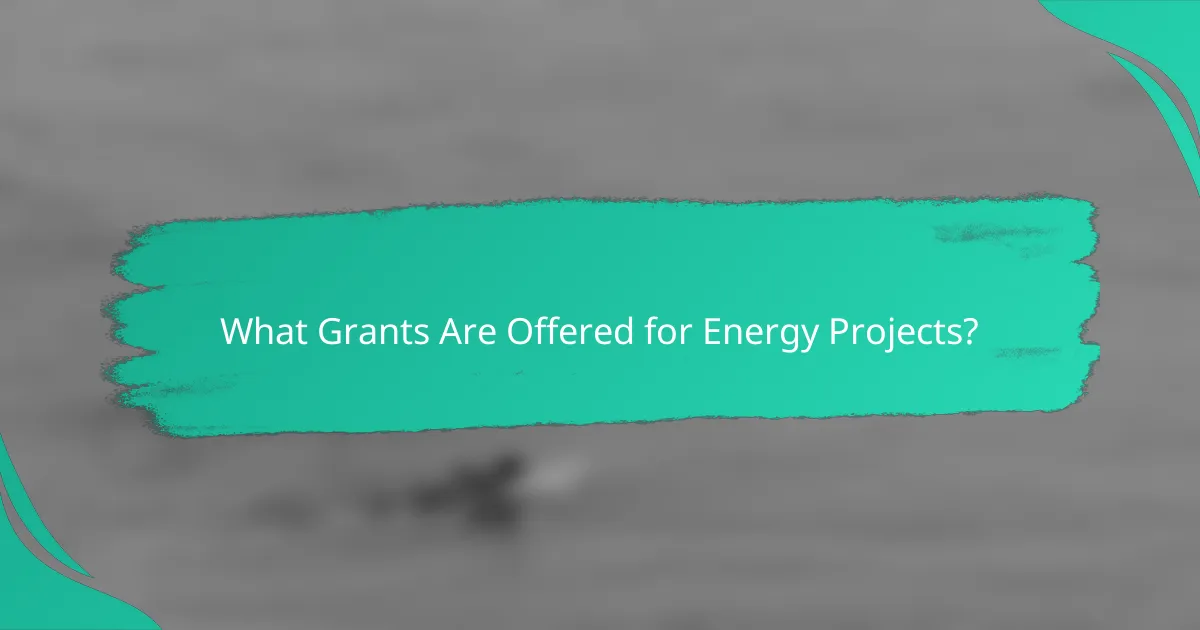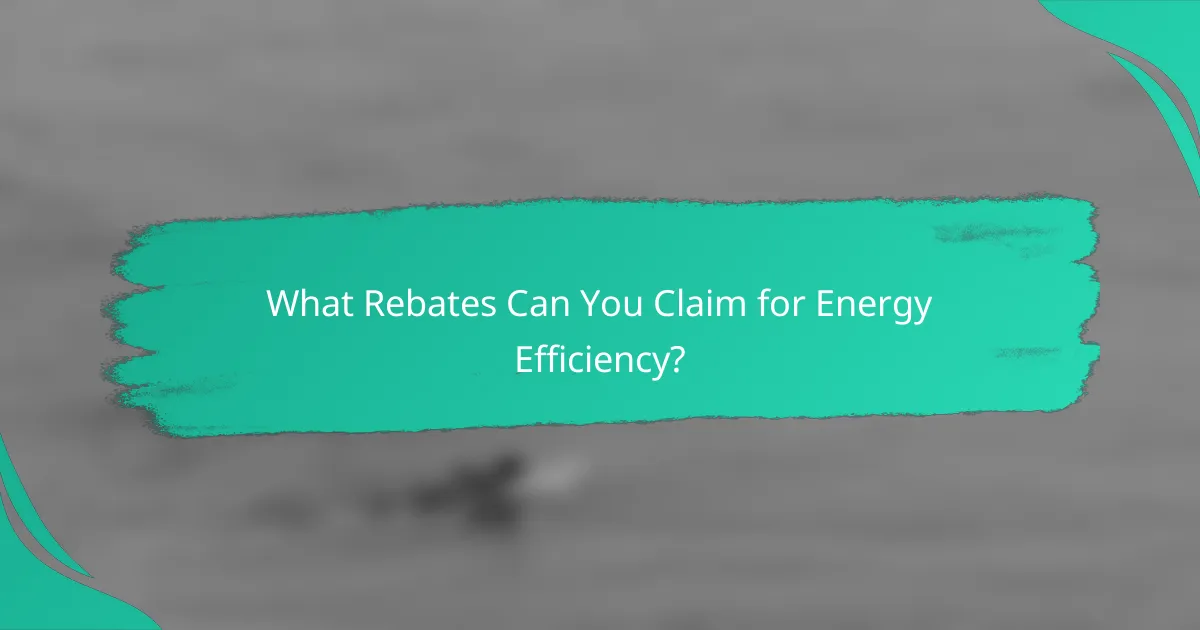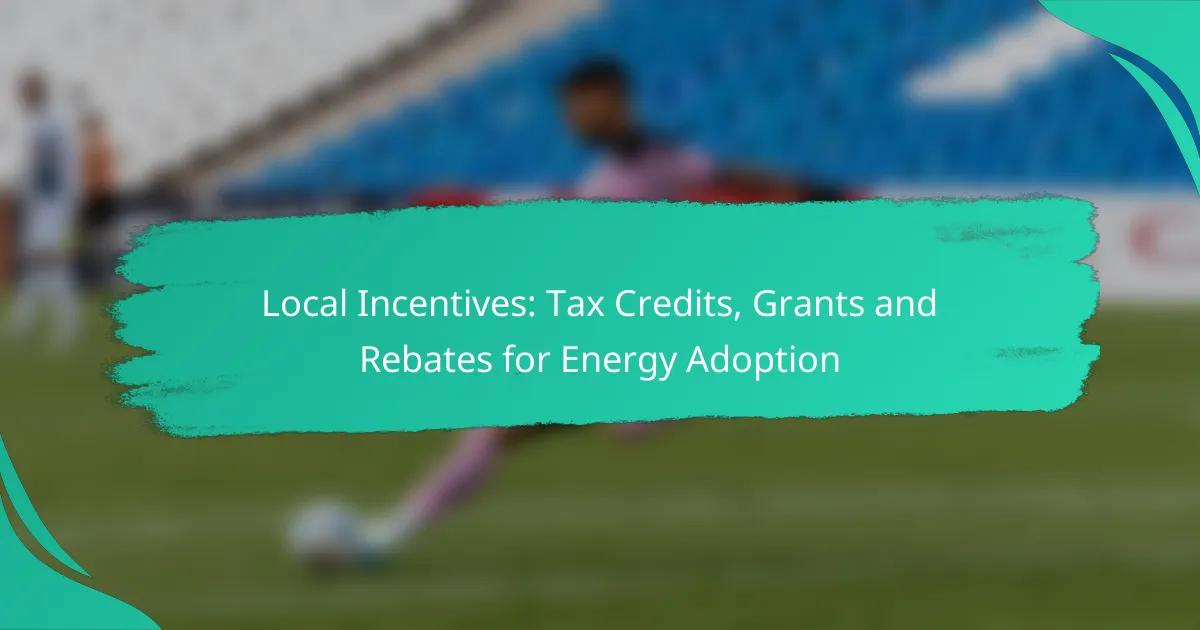Local incentives for energy adoption, such as tax credits, grants, and rebates, play a crucial role in promoting the use of renewable energy and enhancing energy efficiency. By alleviating the initial financial burden, these incentives make it easier for individuals and businesses to invest in sustainable technologies like solar panels and wind turbines.

What Local Incentives Are Available for Energy Adoption?
Local incentives for energy adoption typically include tax credits, grants, and rebates that encourage individuals and businesses to invest in renewable energy and energy efficiency. These financial tools can significantly reduce the upfront costs associated with adopting sustainable technologies.
Tax credits for renewable energy
Tax credits for renewable energy allow individuals and businesses to reduce their tax liability based on the amount they invest in eligible renewable energy systems. Common examples include credits for solar panel installations and wind energy systems, which can cover a substantial percentage of the installation costs.
For instance, in the United States, the federal solar tax credit allows homeowners to deduct a significant portion of their solar installation costs from their federal taxes. It’s essential to check local regulations, as some states offer additional credits that can further enhance savings.
Grants for energy efficiency projects
Grants for energy efficiency projects are funds provided by local governments or organizations to support initiatives that improve energy use in homes and businesses. These grants can cover various projects, such as upgrading insulation, installing energy-efficient windows, or implementing smart energy management systems.
Eligibility for these grants often depends on the project’s expected energy savings and the applicant’s income level. It’s advisable to research local programs, as some municipalities may have specific grants available that can cover a significant portion of project costs.
Rebates for electric vehicle purchases
Rebates for electric vehicle (EV) purchases provide immediate financial incentives to consumers who buy or lease qualifying electric vehicles. These rebates can significantly lower the effective purchase price of an EV, making them more accessible to a broader audience.
For example, many states in the U.S. offer rebates ranging from a few thousand dollars to over ten thousand dollars, depending on the vehicle’s specifications and the buyer’s eligibility. Additionally, local utility companies may provide further incentives, such as rebates for home charging station installations, enhancing the overall value of transitioning to electric vehicles.

How Do Tax Credits Work for Energy Adoption?
Tax credits for energy adoption reduce the amount of tax owed by individuals or businesses that invest in renewable energy technologies. These credits can significantly lower the upfront costs associated with solar panels, wind turbines, and other energy-efficient systems, making them more accessible.
Federal tax credit examples
The federal government offers several tax credits for energy adoption, including the Investment Tax Credit (ITC) for solar energy. Homeowners can receive a credit of around 26% of the installation costs for solar systems through 2022, which will gradually decrease in subsequent years.
Another example is the Residential Energy Efficiency Property Credit, which applies to various energy-efficient home improvements, such as insulation and energy-efficient windows. These credits can help offset costs and encourage homeowners to make sustainable choices.
State-specific tax credits
Many states provide additional tax credits that complement federal incentives. For instance, California offers a state tax credit for solar energy systems, which can further reduce the financial burden on homeowners. Each state has its own rules and percentages, so it’s essential to check local regulations.
Some states may also have credits for energy-efficient appliances or electric vehicle purchases, which can vary widely in terms of eligibility and amounts. Researching your state’s specific offerings can maximize potential savings.
Eligibility requirements
Eligibility for tax credits typically depends on the type of energy system installed and the taxpayer’s income level. Most federal credits require the system to be installed in a primary residence or business and meet specific energy efficiency standards.
State-specific credits may have additional requirements, such as being a resident of the state or using approved contractors for installation. It’s crucial to review these criteria before proceeding with any energy adoption project to ensure compliance and maximize benefits.

What Grants Are Offered for Energy Projects?
Grants for energy projects can significantly reduce the financial burden of adopting renewable energy solutions. These grants are typically provided by federal, state, and local governments to encourage the development and implementation of energy-efficient technologies.
Federal grant programs
Federal grant programs for energy projects are primarily administered through agencies like the Department of Energy (DOE) and the Environmental Protection Agency (EPA). These programs often focus on research, development, and deployment of innovative energy technologies, including solar, wind, and energy efficiency improvements.
Examples of federal grants include the Solar Energy Technologies Office funding and the Energy Efficiency and Conservation Block Grant Program. Eligibility requirements vary, often targeting non-profit organizations, local governments, and educational institutions.
State and local grant opportunities
Many states and local governments offer their own grant programs to promote energy efficiency and renewable energy projects. These grants can vary widely in terms of funding amounts and eligibility criteria, often reflecting local energy goals and priorities.
For instance, some states provide grants specifically for residential solar installations or energy audits. It’s advisable to check with state energy offices or local utility companies for available programs and application details.
Application process for grants
The application process for energy project grants typically involves several key steps. First, identify the specific grant program that aligns with your project goals and review the eligibility criteria and funding limits. Each program will have its own application form and deadlines.
Prepare a detailed project proposal that outlines the objectives, budget, and expected outcomes. Be sure to include any required documentation, such as proof of eligibility or project feasibility studies. Finally, submit your application before the deadline and follow up as necessary to ensure it is being processed.

What Rebates Can You Claim for Energy Efficiency?
You can claim various rebates for energy efficiency improvements, which help offset the costs of upgrades like insulation, energy-efficient appliances, and renewable energy systems. These rebates are typically offered by utility companies and state programs to encourage energy-saving measures.
Utility company rebate programs
Utility companies often provide rebate programs to incentivize customers to adopt energy-efficient technologies. These programs may cover a portion of the costs for upgrading to energy-efficient appliances, HVAC systems, or insulation. For example, a utility might offer a rebate of up to several hundred dollars for qualifying energy-efficient refrigerators or air conditioning units.
To take advantage of these rebates, you usually need to apply through your utility provider’s website or customer service. Keep an eye on deadlines, as some programs have limited funding or seasonal availability.
State-sponsored rebate initiatives
Many states offer their own rebate initiatives to promote energy efficiency among residents. These programs can vary significantly by state, often providing larger rebates for renewable energy installations like solar panels or geothermal systems. For instance, some states may offer rebates that range from a few hundred to several thousand dollars depending on the project size and type.
Check your state’s energy office or website for specific programs and eligibility requirements, as these initiatives can change frequently and may have specific application processes.
Eligibility criteria for rebates
Eligibility for energy efficiency rebates typically depends on several factors, including the type of improvement, the equipment’s energy efficiency rating, and sometimes your income level. Many programs require that the upgrades meet specific energy standards, such as ENERGY STAR certification.
Before applying, review the eligibility criteria carefully. Some rebates may require pre-approval before installation, while others might need documentation proving the energy savings achieved after the upgrade.

How to Maximize Your Benefits from Local Incentives?
To maximize your benefits from local incentives for energy adoption, it’s essential to understand how to effectively combine various tax credits, grants, and rebates. By strategically applying for multiple incentives, you can significantly reduce your overall costs and enhance your return on investment.
Combining tax credits and grants
Combining tax credits and grants can amplify your savings when adopting energy-efficient technologies. For instance, if you install solar panels, you may qualify for a federal tax credit while also receiving a state grant to cover part of the installation costs. This dual approach can lower your upfront expenses and improve your financial outlook.
When considering combinations, check the eligibility requirements for each incentive. Some grants may require you to forgo certain tax credits, so it’s crucial to evaluate which options provide the most substantial benefits based on your situation.
Strategies for applying for multiple incentives
To effectively apply for multiple incentives, start by researching all available programs at the local, state, and federal levels. Create a checklist of requirements for each incentive, including deadlines and necessary documentation. This organized approach will help you avoid missing out on potential savings.
Additionally, consult with a tax professional or an energy advisor who can guide you through the application process. They can help identify the best combinations of incentives and ensure that your applications are completed accurately and submitted on time, maximizing your potential benefits.

What Are the Prerequisites for Accessing Local Incentives?
To access local incentives such as tax credits, grants, and rebates for energy adoption, applicants typically need to meet specific requirements set by local authorities. These prerequisites often include documentation, project eligibility criteria, and compliance with local regulations.
Documentation needed
Applicants must provide various forms of documentation to qualify for local incentives. Commonly required documents include proof of residence or business location, project plans, and receipts for any related expenses. Additionally, some programs may require energy audits or certifications from approved professionals.
It’s essential to keep all relevant paperwork organized and accessible, as missing documents can delay or disqualify applications. Consider creating a checklist of required documents specific to your local incentive program to ensure nothing is overlooked.
Project eligibility criteria
Eligibility for local incentives often hinges on the type of energy project being undertaken. Many programs prioritize renewable energy installations, such as solar panels or energy-efficient appliances. Projects may also need to meet certain performance standards or be completed within a specified timeframe.
Local governments may set additional criteria, such as income thresholds for applicants or requirements for using local contractors. Researching these criteria in advance can help streamline the application process and increase the chances of approval.

What Trends Are Emerging in Energy Adoption Incentives?
Emerging trends in energy adoption incentives focus on increasing accessibility and promoting sustainable practices. Governments and organizations are enhancing tax credits, grants, and rebates to encourage the transition to renewable energy sources.
Increased Federal and State Tax Credits
Federal and state tax credits are becoming more generous, aiming to reduce the upfront costs of renewable energy systems. For instance, the federal solar tax credit allows homeowners to deduct a significant percentage of the installation costs from their federal taxes.
Many states offer additional credits that can further lower the financial burden. Homeowners should check their local regulations to understand the specific benefits available in their area, as these can vary widely.
Grants for Energy Efficiency Projects
Grants are increasingly available for energy efficiency projects, particularly for low-income households and community organizations. These grants can cover a substantial portion of costs associated with energy upgrades, such as insulation, energy-efficient appliances, and heating systems.
Organizations like the Department of Energy often provide funding opportunities that can be applied for annually. It’s essential to stay informed about application deadlines and eligibility requirements to maximize potential funding.
Rebates for Renewable Energy Installations
Rebates for renewable energy installations are becoming more common, offering immediate financial relief to consumers. For example, many utility companies provide rebates for solar panel installations, which can significantly reduce the overall cost.
These rebates typically require the installation to meet certain efficiency standards. Homeowners should verify the specific criteria and application process with their utility provider to ensure they receive the maximum rebate possible.
